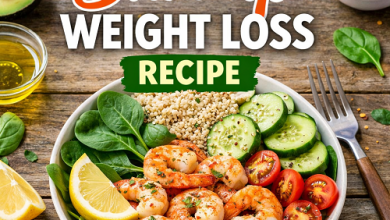The Surprising Foods That Fight Cancer While You Keep Meat on the Menu

Cancer is one of the most dreaded diagnoses anyone can face, and for decades, diet has been at the center of discussions about prevention. Many studies have linked high consumption of red or processed meat to an increased risk of certain cancers, particularly colorectal cancer. As a result, some people believe that going fully vegetarian or vegan is the only dietary path toward lowering their cancer risk.
But what if you enjoy meat and aren’t ready to give it up? The good news is that you don’t necessarily have to. While moderation is key, research shows that adding certain nutrient-rich foods to your plate can significantly lower your cancer risk—even if meat remains part of your diet.
The surprising foods that help fight cancer, how they work at the cellular level, and how you can combine them with meat-based meals without feeling deprived. By the end, you’ll discover that cancer-fighting nutrition is not about extreme restriction but about balance, variety, and strategic food pairing.
Why Food Matters in Cancer Prevention
Before we dive into the list of foods, let’s take a moment to understand why diet plays such a big role in cancer prevention. Cancer develops when genetic mutations cause uncontrolled cell growth. While genetics, environment, and lifestyle factors all contribute, diet has a major influence on whether these abnormal cells grow, spread, or are destroyed by your body’s natural defenses.
Here’s how foods help in cancer prevention:
- Antioxidants protect DNA from damage caused by free radicals.
- Anti-inflammatory compounds lower chronic inflammation, which is linked to cancer development.
- Fiber-rich foods improve gut health, speed up digestion, and reduce exposure of the intestinal lining to carcinogens.
- Phytochemicals (plant compounds) directly interfere with cancer cell growth and stimulate the body’s detox systems.
- Healthy fats regulate hormones, lowering risks of hormone-related cancers.
The trick is to eat foods that supply these protective compounds while moderating foods that may contribute to cancer risk—like heavily processed meats, fried foods, and sugar-heavy diets.
The Surprising Cancer-Fighting Foods You Can Add Today
Here’s the good news: many everyday foods contain powerful cancer-fighting compounds. Let’s explore the ones backed by the strongest research.
1. Cruciferous Vegetables: Nature’s Detox Agents
Examples: Broccoli, Brussels sprouts, kale, cauliflower, bok choy
Cruciferous vegetables contain sulforaphane and indole-3-carbinol, compounds known to deactivate carcinogens and protect DNA. Studies suggest that sulforaphane helps the liver detoxify harmful substances and may slow the growth of cancer cells.
How to enjoy with meat: Add a side of roasted Brussels sprouts or steamed broccoli to grilled chicken or steak. Stir-fried beef with bok choy is another simple way to combine meat with these cancer-fighting greens.
2. Garlic and Onions: Powerful Sulfur Compounds
Why they matter: Garlic, onions, leeks, and shallots are rich in organosulfur compounds that enhance immune function and block the formation of carcinogens. Research has linked higher garlic consumption with reduced risk of stomach, esophageal, and colorectal cancers.
How to enjoy with meat: Use garlic and onions generously when seasoning meat dishes. Garlic-marinated chicken or beef sautéed with onions packs flavor and protection.
3. Berries: Tiny Fruits with Big Power
Examples: Blueberries, strawberries, raspberries, blackberries
Berries are rich in ellagic acid and anthocyanins, antioxidants that protect cells from oxidative stress. They also help slow tumor growth and deactivate cancer-causing substances.
How to enjoy with meat: Serve grilled chicken or turkey with a side salad topped with fresh berries. Or make a blueberry sauce for lean pork tenderloin.
4. Tomatoes: Lycopene for Prostate Protection
Tomatoes are the richest source of lycopene, a carotenoid linked to reduced risk of prostate and lung cancers. Cooking tomatoes (like in sauces or stews) actually increases lycopene availability.
How to enjoy with meat: Pair spaghetti Bolognese with tomato-rich sauce, or top grilled fish with fresh salsa made from tomatoes, onions, and herbs.
5. Green Tea: A Cancer-Fighting Drink
Green tea is packed with catechins, especially epigallocatechin gallate (EGCG), which inhibits cancer cell growth and prevents angiogenesis (the formation of blood vessels that feed tumors).
How to enjoy with meat: Swap soda or alcohol for a cup of green tea at mealtimes. It pairs surprisingly well with grilled or roasted meat.
6. Turmeric: The Golden Spice
The active compound in turmeric, curcumin, has powerful anti-inflammatory and antioxidant properties. It interferes with multiple pathways of cancer cell growth and has been studied for breast, colon, and pancreatic cancers.
How to enjoy with meat: Use turmeric in spice rubs for chicken, beef, or lamb. Turmeric-marinated grilled chicken is both delicious and protective.
7. Leafy Greens: Chlorophyll and Folate Boost
Examples: Spinach, kale, Swiss chard, collard greens
Leafy greens provide chlorophyll, which may help block carcinogens from binding to DNA. They’re also high in folate, a vitamin important for DNA repair.
How to enjoy with meat: Add a side of spinach salad to your steak, or sauté kale in garlic and olive oil to serve alongside roast chicken.
8. Legumes: Fiber and Phytochemicals
Examples: Lentils, beans, chickpeas, peas
Legumes are rich in fiber, which promotes healthy digestion and reduces risk of colon cancer. They also provide saponins and lignans, phytochemicals that slow cancer cell growth.
How to enjoy with meat: Try chili with beans and lean beef, or pair grilled chicken with a chickpea salad.
9. Nuts and Seeds: Healthy Fats for Hormone Balance
Examples: Walnuts, almonds, flaxseeds, chia seeds, sunflower seeds
Nuts and seeds supply omega-3 fatty acids, vitamin E, and lignans, which may reduce the risk of breast and prostate cancers. Flaxseeds, in particular, are rich in compounds that regulate estrogen metabolism.
How to enjoy with meat: Sprinkle seeds over chicken salad, or use crushed walnuts as a crust for baked salmon.
10. Mushrooms: Immune-Boosting Powerhouses
Examples: Shiitake, maitake, reishi, button mushrooms
Mushrooms contain beta-glucans, compounds that stimulate the immune system to recognize and destroy abnormal cells. Some varieties, like reishi, have been used in cancer-supportive therapies.
How to enjoy with meat: Add mushrooms to beef stir-fries or sauté them as a side dish with chicken or pork.
11. Citrus Fruits: Vitamin C and Flavonoids
Examples: Oranges, lemons, limes, grapefruits
Citrus fruits provide vitamin C, which enhances immune defenses, and flavonoids that inhibit tumor growth. They also aid in detoxifying carcinogens.
How to enjoy with meat: Use lemon juice in marinades for grilled chicken or fish. Orange zest also adds flavor to pork dishes.
12. Whole Grains: Fiber for Colon Protection
Examples: Brown rice, quinoa, oats, barley, whole wheat
Whole grains are high in fiber, selenium, and phytochemicals that lower colorectal cancer risk. They help regulate digestion and prevent harmful compounds from lingering in the gut.
How to enjoy with meat: Serve grilled chicken with quinoa salad, or make beef stir-fry with brown rice.
How to Keep Meat in Your Diet—Safely
Now that we’ve highlighted cancer-fighting foods, let’s address the elephant in the room: meat. Studies consistently show that diets heavy in processed and red meats increase cancer risk. But meat itself is not inherently “bad”—it depends on the type, portion size, and cooking method.
Here’s how to enjoy meat while lowering risks:
- Choose lean meats: Opt for skinless chicken, turkey, fish, or lean cuts of beef and pork.
- Limit processed meats: Sausages, bacon, hot dogs, and deli meats should be occasional treats, not staples.
- Watch portion sizes: Stick to 3–4 ounces (about the size of your palm) per serving.
- Cook wisely: Avoid charring or burning meat, as this produces harmful compounds like heterocyclic amines (HCAs). Instead, bake, steam, poach, or grill lightly.
- Pair with plants: Always balance meat with vegetables, whole grains, and herbs rich in cancer-fighting compounds.
The Power of Food Pairing
The most powerful cancer-fighting diets don’t rely on single “superfoods” but on synergy—how foods work together. For example:
- Tomatoes + Olive Oil: Olive oil enhances lycopene absorption from tomatoes.
- Turmeric + Black Pepper: Piperine in black pepper boosts curcumin absorption by up to 2000%.
- Iron-rich Meat + Vitamin C-rich Foods: Citrus fruits improve iron absorption, helping prevent anemia without excessive red meat intake.
By combining foods thoughtfully, you amplify their protective effects.
Building a Cancer-Fighting Plate
Here’s what a balanced, meat-inclusive, cancer-fighting meal might look like:
- Protein: Grilled salmon, chicken, or lean beef (moderate portion).
- Vegetables: Half your plate filled with colorful vegetables like broccoli, spinach, or roasted peppers.
- Whole Grains or Legumes: Brown rice, quinoa, or lentils.
- Healthy Fats: Olive oil, avocado, or nuts.
- Flavor Enhancers: Garlic, onions, turmeric, ginger, or herbs.
- Drink: Green tea or water with lemon.
This type of plate keeps meat on the menu while surrounding it with protective foods.
Final Thoughts
You don’t need to give up meat to lower your cancer risk. By choosing lean cuts, limiting processed meats, and cooking wisely, you can still enjoy meat while protecting your health. The real secret lies in loading your plate with cancer-fighting foods like cruciferous vegetables, berries, tomatoes, garlic, mushrooms, legumes, and whole grains.
Cancer prevention is not about deprivation—it’s about empowerment through food choices. Every meal is an opportunity to strengthen your body’s natural defenses. With balance, variety, and mindful eating, you can savor your favorite dishes and reduce your risk of cancer at the same time.




